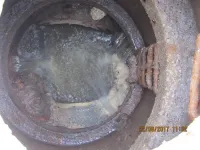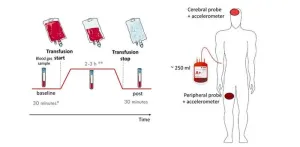(Press-News.org) The ambitious project PIPEON* will develop new robotic and AI-based technologies for mapping, monitoring, and maintaining Europe’s sewer networks using autonomous “thinking” robots and AI-based modelling and analysis tools.
The development and application of such new technologies would have major societal, environmental and economic impact. Instead of repairing in-sewer defects and removing blockages after streets and homes have been flooded with sewage, defects can be quickly identified and repaired and blockages removed when they are still small. Early, preventative repair and maintenance actions will limit the frequency and volume of sewage spills from sewer overflows into rivers, a key target of the new Urban Wastewater Treatment Directive, which has been recently approved by the European Commission.
Lots of challenges
The project leader, Professor Maarja Kruusmaa at TalTech, explained that although repair and cleaning are very practical problems, working in sewer environments means that their solution first requires the achievement of fundamentally new research results. "Robots are mostly used to perform dirty, tedious and dangerous work and are sent to hard-to-reach places instead of people", says Kruusmaa, adding: "but few people have remembered that one of the most complex, dangerous and hard-to-reach environments in the world is right here under our feet when we walk home from work every day". Working in sewers presents a myriad of technological challenges. "There are currently no robots that can work without direct human intervention and last for a long time in such a featureless, harsh environments.” Thus, we need to develop new types of locomotion mechanisms so that robots are able to move even in wastewater, containing solids and fats. New control approaches so that robots can navigate in darkness in pipes with few landmarks, physically restricted by ever changing pipe directions and sizes. Sewer robots need to be smart so that they can survive for days on their own. Underground, there are usually no communication options or GPS signals and there are no precise maps of sewer networks "We will use machine learning algorithms to navigate underground as well as to identify potential defects. But robots are small, and we cannot use unlimited computing power, as is the case, for example, with large language models like ChatGPT. We need to make sure that the robot's own small on-board computer is able to process, learn and decide, and this requires a completely different type of artificial intelligence," Kruusmaa explains.
12 European partners are involved in the project
The project received funding from the highly competitive European Framework Programme on Robotics and Artificial Intelligence. Kruusmaa commented that "We managed to convince the European Commission that, on the one hand, the project has a very big impact on the environment, the economy and society, and that on the other hand, we are the best team." The team, led by TalTech, is multi-disciplinary and has 12 partners, including the Norwegian University of Science and Technology, the University of Sheffield, and several European innovative technology companies, such as an Italian start-up Herobots who are developing novel actuation mechanisms, and also several water utilities.
Simon Tait, Professor of Water Engineering at the University of Sheffield explained that "with over 3M km of sewer in Europe, subject to climate change, new environmental obligations and an aging work force, water utilities need radically new approaches to maintaining their service to citizens’ – we believe that autonomous in-sewer robots is an approach that can help meet these challenges". Our ambition is that by the end of the project we will have evaluated robot prototypes in several European sewer networks, opening the potential for widespread deployment of robots in sewers in the 2030’s.
*PIPEON: Robotics and AI for Sewer Pipe Inspection and Maintenance is a 4 year, €8M, multi-partner, research and development project, funded by the European Union and led by Tallinn University of Technology (TalTech).
END
Robots get smarter to work in sewers
2025-01-31
ELSE PRESS RELEASES FROM THIS DATE:
Speech Accessibility Project data leads to recognition improvements on Microsoft Azure
2025-01-31
Microsoft's Azure AI Speech platform achieved “significant improvements” in recognizing non-standard English speech thanks to recordings and transcripts from University of Illinois Urbana-Champaign Speech Accessibility Project participants. Its accuracy gains range from 18% to 60%, depending on the speaker’s disability.
The changes are currently rolling out on Microsoft's Cloud endpoint for third-party customers.
Until now, the majority of voice recognition technology trained using recordings and transcriptions from audiobooks. But an audiobook narrator and an individual with aphasia after a stroke sound different.
When the Speech ...
Tigers in the neighborhood: How India makes room for both tigers and people
2025-01-31
In India, tigers haven’t just survived − they’ve made a comeback. Despite a growing population and increasing pressure on their habitats, the number of wild tigers is rising. The reason? A combination of ecological restoration, economic initiatives, and political stability. And just as important: a deeply rooted reverence for tigers that has fostered a culture where humans and predators can coexist.
How do you protect an endangered species when that species is a tiger − a predator that also poses a threat to humans? India has found a way by combining protected reserves with areas where tigers and people share space. The result? A 30% increase in ...
Grove School’s Arthur Paul Pedersen publishes critical essay on scientific measurement literacy
2025-01-31
Arthur Paul Pedersen, faculty research scientist with the CUNY Remote Sensing Earth Systems (CREST) Institute and adjunct assistant professor of computer science at The City College of New York’s Grove School of Engineering, is lead author of a critical essay on measurement in scientific discourse. The essay, published in the journal of Proceedings of the National Academy of Sciences, warns of the dangerous implications of measurement illiteracy in contemporary scientific discourse and urges broad, ...
Moffitt study finds key biomarker to predict KRASG12C inhibitor effectiveness in lung cancer
2025-01-31
TAMPA, Fla. (Jan. 31, 2025) — A new study from Moffitt Cancer Center could help doctors predict how well patients with a specific type of lung cancer will respond to new therapies. The research, published in Clinical Cancer Research, found that measuring the interaction between two proteins, RAS and RAF, could provide valuable insights into the effectiveness of treatments for patients with KRASG12C-mutant non-small cell lung cancer, a type of lung cancer known for being particularly difficult to treat.
The findings revealed that tumors with higher levels ...
Improving blood transfusion monitoring in critical care patients: Insights from diffuse optics
2025-01-31
Red blood cell transfusions (RBCTs) are life-saving treatments for critically ill patients suffering from anemia, a condition where the body lacks enough healthy red blood cells to deliver oxygen effectively. While effective in increasing oxygen levels in the blood, transfusions can disrupt blood flow and oxygen distribution, potentially causing harm to vital organs like the brain. To address this, researchers are exploring new tools to monitor these effects more precisely.
A recent study reported in Biophotonics Discovery investigated a novel technology called hybrid diffuse optics (DO), which uses near-infrared light to continuously measure changes in blood flow and oxygen ...
Powerful legal and financial services enable kleptocracy, research shows
2025-01-31
Powerful legal and financial service industries are enabling kleptocracy and corrupt elites to operate with relative impunity, a new study shows.
The research details how “enablers” from these industries exploit deregulation and the under-enforcement of the law to game the system. They can offshore their clients' wealth, and enhance their reputations and influence via philanthropy, political donations, and the use of the UK's punitive libel regime.
Most of this “enabling” is likely ...
Carbon capture from constructed wetlands declines as they age
2025-01-31
COLUMBUS, Ohio – Constructed wetlands do a good job in their early years of capturing carbon in the environment that contributes to climate change – but that ability does diminish with time as the wetlands mature, a new study suggests.
Researchers examined soil core samples taken from two constructed freshwater wetlands and compared them to data from previous studies of the same wetlands over 29 years to determine how well human-made wetlands sequester — or capture and store — ...
UCLA-led study establishes link between early side effects from prostate cancer radiation and long-term side effects
2025-01-31
Men undergoing radiation therapy for prostate cancer who experience side effects early in treatment may face a higher risk of developing more serious long-term urinary and bowel health issues, according to a new study led by investigators from the UCLA Health Jonsson Comprehensive Cancer Center.
The study found that patients who experienced moderate acute urinary side effects in the first three months after radiation were nearly twice as likely to develop late urinary complications years later compared to those without early symptoms. Similarly, patients with early bowel side effects had nearly double the risk of chronic bowel issues.
The findings, ...
Life cycles of some insects adapt well to a changing climate. Others, not so much.
2025-01-31
As insect populations decrease worldwide in what some have called an "insect apocalypse," biologists are desperate to determine how the six-legged creatures are responding to a warming world and to predict the long-term winners and losers.
A new study of Colorado grasshoppers shows that, while the answers are complicated, biologists have much of the knowledge they need to make these predictions and prepare for the consequences.
The findings, published Jan. 30 in the journal PLOS Biology, come thanks to the serendipitous ...
With generative AI, MIT chemists quickly calculate 3D genomic structures
2025-01-31
CAMBRIDGE, MA -- Every cell in your body contains the same genetic sequence, yet each cell expresses only a subset of those genes. These cell-specific gene expression patterns, which ensure that a brain cell is different from a skin cell, are partly determined by the three-dimensional structure of the genetic material, which controls the accessibility of each gene.
MIT chemists have now come up with a new way to determine those 3D genome structures, using generative artificial intelligence. Their technique can predict thousands of structures in just minutes, making it much speedier than existing experimental methods for analyzing the structures.
Using this technique, researchers could more ...




